Convert Excel to PDF effortlessly with reliable tools that preserve formatting and ensure compatibility across platforms. Whether you’re sharing financial reports, business proposals, or data analysis, converting Excel to PDF ensures that your documents maintain their integrity and appearance. With just a few clicks, you can transform complex spreadsheets into universally accessible PDF files, making collaboration and sharing seamless. Say goodbye to compatibility issues and hello to streamlined document management with Convert Excel to PDF. Experience the convenience of converting Excel files to PDF format and unlock a world of possibilities for sharing and presenting your data effectively. Take control of your document workflows and elevate your productivity with the simple yet powerful solution of Convert Excel to PDF.
This Tutorial Covers:
- Why use Excel to PDF
- Save Excel documents as PDF files
- Export as PDF from Excel
- Publish as PDF Quick Access Toolbar Command
- Email as PDF Attachment Quick Access Toolbar Command
1. Why use Excel to PDF?
Converting an Excel file to PDF format can be useful for several reasons:
- Easy to share: PDF files are a standard format that can be easily shared with others, regardless of the software or operating system they are using. This ensures that everyone can view and print the document as intended, without any formatting issues.
- Preserves formatting: When you convert an Excel file to PDF format, the formatting of the document is preserved. This means that charts, graphs, tables, and other visual elements will appear the same way in the PDF as they did in the original Excel file.
- Security: PDF files can be password protected, preventing unauthorized access to the document. This can be particularly useful when dealing with sensitive or confidential information.
- Archiving: PDF files are ideal for archiving because they can be easily saved and stored for future reference. This ensures that the document can be accessed and viewed in the same way, regardless of how much time has passed since it was created.
Overall, converting an Excel file to PDF format can be useful for sharing, preserving, and protecting your data.
2. Save Excel documents as PDF files:
Excel 2007 introduced the ability to export Excel files straight to PDF, despite the fact that both the.pdf and.xls formats have been around for a long and have always been well-liked by users. Therefore, you can quickly and easily convert an Excel file to a PDF file if you have any version of Excel 2007 through 365.
Microsoft Excel allows you to save one or more worksheets or the complete workbook as a PDF file and export specific ranges or tables.
The steps to save Excel documents as PDF files are described below:
Step 1: Open your Excel workbook, then pick the sheets or ranges you want to export as a PDF.
- Place the cursor in any cell of the table you want to export.
- To export a certain worksheet, simply make it active by clicking on this sheet’s tab.
- Select all of the spreadsheets you want to convert. Click the tab for the first sheet while holding down Shift, then click the tab for the worksheet you wish to pick to select neighboring sheets. Hold down Ctrl while clicking the tabs of each sheet you want to save as a PDF to choose non-adjacent sheets.
Skip this step if you wish to save the complete workbook as a single PDF file.
Step 2: Go to “File” tab and after that select “Save a Copy” option. The option name may differ in other Excel versions.
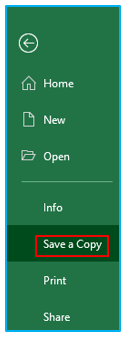
Step 2: Choose PDF (.*pdf) from the “Save as type” drop-down list in the “Save As” dialog window.
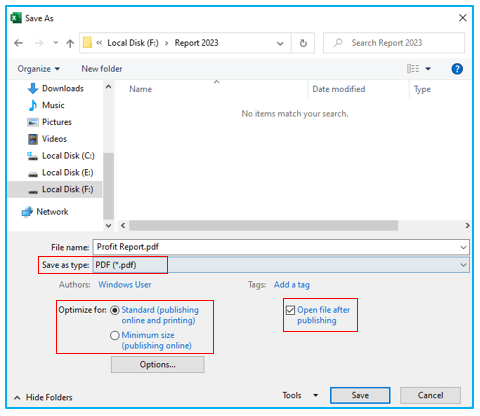
If you want to view the generated PDF file after saving, make sure the “Open file after publishing” check box is selected.
Under Optimize for, pick one of the following options:
- Click “Standard (publishing online and printing)” if the generated PDF document requires good print quality.
If print quality is less essential than PDF file size, choose “Minimum size (publishing online)”.
Step 3: In the window’s lower left corner, select the “Options…” button.
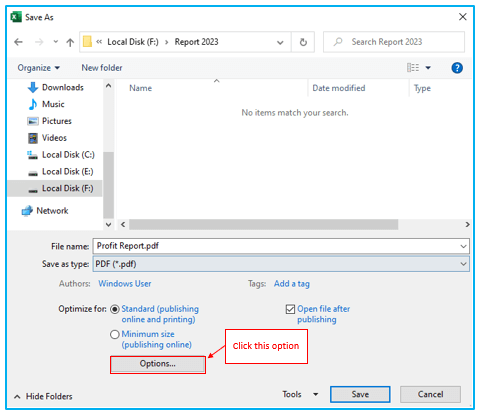
Step 4: The Options dialog box will pop up, and you can then choose an option based on your requirements:
Selection – This will export the range that is currently being used.(s).
Active sheet(s) – The current worksheet or all of the selected worksheets will be saved as a PDF file using this method.
Table – This will export the table that is now under your mouse pointer, or the active table.
Entire workbook – Self-explanatory.
To finish, simply click the OK button to close the dialog.
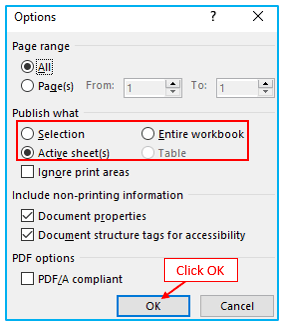
As you can see, using the built-in Excel tools, exporting Excel files to PDF is simple. Microsoft Excel only offers a few basic options, of course, but with a little practice, one may learn to set up the source files such that no additional adjustments are required. Anyhow, let’s look at Adobe’s options if you’re not satisfied with Excel’s Save As feature’s capabilities.
3. Export as PDF from Excel:
There is an Export option in the File menu, but I never really paid attention to it.
You can actually use this to export your file as a PDF, it turns out!
The following steps will explain how to export your Excel file as a PDF:
Step 1: Activate the “File” tab. Select the “Export” tab. Choose “Create PDF/XPS Document”. Select “Create PDF/XPS” from the menu.
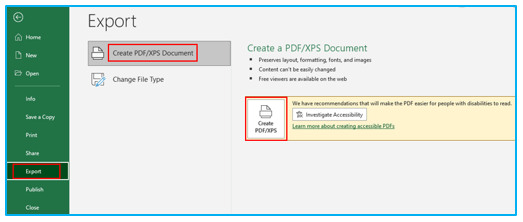
Step 2: This will open the Save As menu-like “Publish as PDF or XPS” menu, where you can select the publication’s location and access additional PDF “Options”.
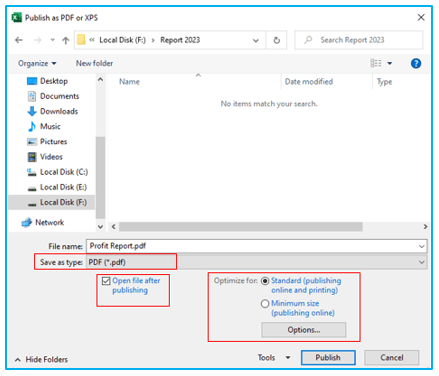
4. Publish as PDF Quick Access Toolbar Command:
To save time, you can skip the File tab step by adding the publish as PDF command to the quick access toolbar.
The steps to publishing as PDF Quick Access Toolbar Command are described below:
Step 1: Select “Customize Quick Access Toolbar” from the menu by doing a right click anywhere on the fast access toolbar.
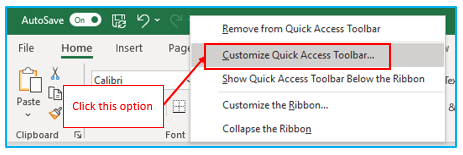
Step 2: The “Excel Options” menu will then appear as a result. You can add the “Publish as PDF or XPS” command from there.
- Make sure the Options menu’s “Quick Access Toolbar” tab is selected.
- Choose “All Commands” from “Choose commands from”.
- Select “Publish as PDF or XPS” as you scroll down.
- To include the command in your list of Quick Access Toolbar commands, click the “Add” button.
- Select “OK” from the menu.
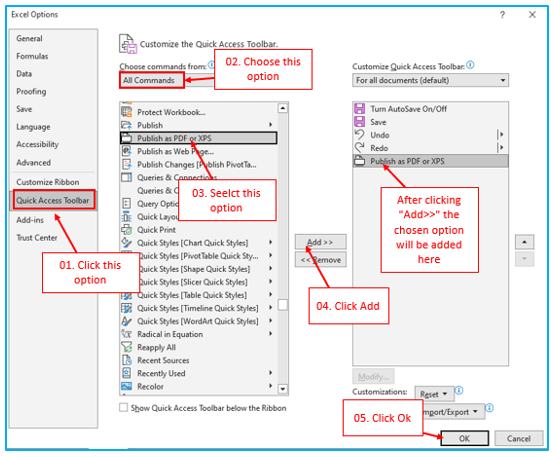
You may now publish your Excel file as a PDF by using this command from the Quick Access Toolbar.

5. Email as PDF Attachment Quick Access Toolbar Command:
This is one of my favorite items on the list because it serves two purposes. Your Excel file will be converted to a PDF, and after that, a new email message with the PDF attached will be created.
None of it required any coding!
If you need to email your files as PDFs, this is quite helpful.
The steps to Email as PDF Attachment Quick Access Toolbar Command are described below:
Step 1: Select “Customize Quick Access Toolbar” from the menu by doing a right click anywhere on the fast access toolbar.

Step 2: The “Excel Options” menu will then appear as a result. From there, you may choose the “E-mail as PDF Attachment” command.
- Make sure the Options menu’s “Quick Access Toolbar” tab is selected.
- Choose “All Commands.”
- Scroll down to “E-mail as PDF Attachment” and select it.
- Choosing the “Add” button will add the command to your list of Quick Access Toolbar commands.
- Select “OK” from the menu.
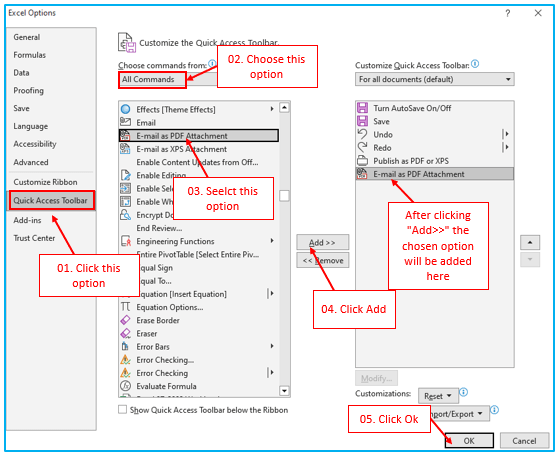
The E-mail as PDF Attachment command will then be added to your quick access toolbar.
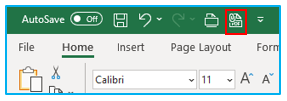
Step 3: When you use this command, a new Outlook email is automatically created with the name of the Excel workbook as the subject line. The Excel file that was converted to PDF will also be included as an attachment.
This will save you a lot of clicks.
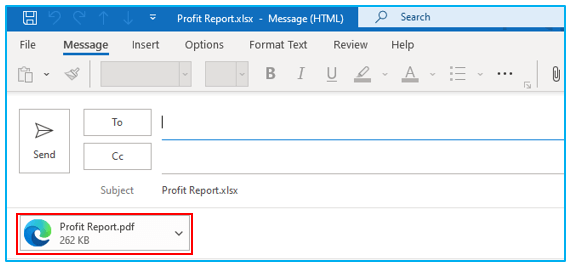
Converting from Excel to PDF format is a task that is commonly performed by many people. Fortunately, there are several easy options available to complete this task. Whether you need to convert an Excel file to PDF for sharing, archiving, or protecting your data, the process can be accomplished quickly and easily with the right tools. By exploring these options, you can choose the method that is best suited to your needs and preferences and complete the task with ease.
Application of Convert Excel to PDF
- Document Preservation: Preserve the formatting, layout, and integrity of Excel files when sharing or archiving them as PDFs.
- Universal Compatibility: Ensure compatibility across different devices, operating systems, and software applications by converting Excel files to PDF format.
- Secure Sharing: Protect sensitive information by converting Excel files to password-protected PDFs before sharing them via email or cloud storage.
- Professional Presentations: Create polished and professional presentations by converting Excel charts, graphs, and tables into high-quality PDF documents.
- Print Optimization: Prepare Excel spreadsheets for printing by converting them to PDF format, ensuring consistent formatting and eliminating printing errors.
- Regulatory Compliance: Meet regulatory requirements or industry standards by converting financial reports, invoices, or audit trails from Excel to PDF for documentation and archiving.
For ready-to-use Dashboard Templates:
